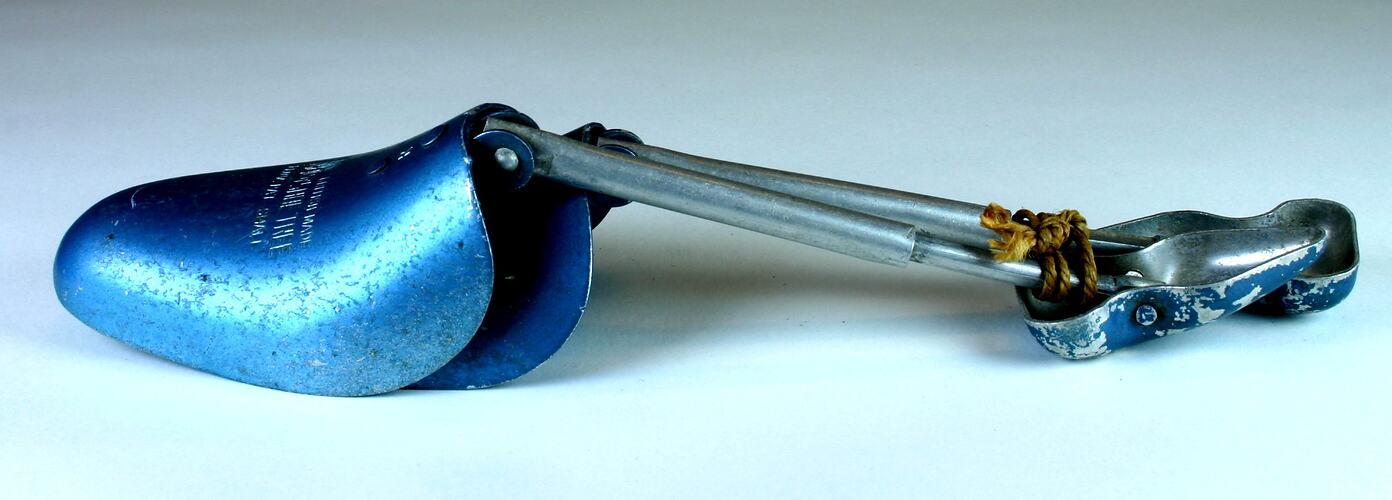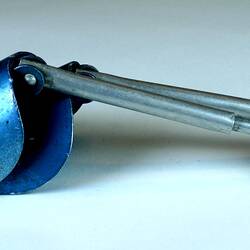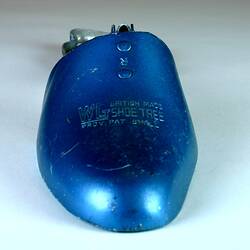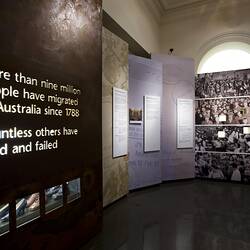Summary
Alternative Name(s): Shoetrees
This pair of blue aluminium shoe trees were most likely used by StanioFancoff to help maintain the shoe's original shape and help prevent creasing and cracking. Although shoetrees are available for both women's and men's shoes, the inscription of 'SMALL' and the indicators 'L'(left) and 'R' (right) suggests this pair were shoe specific. Inserted within the shoe, the shoetrees were an important part in Stanio's after shoe production care procedures.
Stanio Ivanoff Fancoff was born in 1908 in Bojentsi, a small village in Bulgaria. At age 11, Stanio left home to learn the shoemaking trade. In 1929, he immigrated to Melbourne, settled in Fitzroy and began to work for the V.G. Zemancheff & Sons basket shoe factory in South Melbourne. In1936, he married Dorotea Georgi Touzou who had recently arrived in Australia. Around this time, Stanio set up his own shoemaking business from home, with Georgi, her cousin and sister weaving the shoes which he then assembled. Select shoe samples were then taken to Sydney and Tasmania for sale. In 1942, Georgi and Stanio moved to Broken Hill for Georgi's health; there daughter Nancy was born and Stanio set up a shoe shop/factory. In 1945, Georgi died and by 1950 Stanio and Nancy had moved to Adelaide where he again opened a shoemaking business and shop. He passed away in 1978, having been in the shoemaking business for 59 years. This collection documents his migration and working life experiences.
Physical Description
Blue aluminium pair of shoetrees. Shaped within the shoe's vamp, this first section is coated within blue hue and has the impressed text plus is assigned 'R' (right) and 'L' (left) indicators. Riverted to this aluminium vamp is an adjustable silver rod, that leads to an aluminium blue hued heel insertion that manouvers upon a hinged construct. Although in good condition, these shoetrees exhibit various scratches suggesting both ageing and extensive use.
Significance
This collection is significant in documenting a small migrant business as well as the fashion of a particular period. It is well provenanced and charts the application of trade skills in a new country. It also illustrates the stages of hand shoe manufacture from the 1930s, demonstrating the enduring nature of the tools and patterns that were used.
More Information
-
Collecting Areas
-
Acquisition Information
Donation from Nancy Vasileff, 21 Mar 2007
-
Past Owner or User
-
Inscriptions
Impressed: WG/BRITISH MADE/SHOE TREE/PROV. PAT SMALL. Impressed: R Impressed: l
-
Classification
-
Category
-
Discipline
-
Type of item
-
Overall Dimensions
70 mm (Width), 20 mm (Depth), 280 mm (Height)
-
Maximum dimensions
282 mm (Length), 76 mm (Width), 48 mm (Height)
Measurement From Conservation. above measurements for part 1 (right). Part 2 (left) dimensions (l) 285 x (W) 70 x (h) 47
-
References
R.A. Salaman, 'Dictionary of Leather-working Tools c.1700-1950 and Tools of Allied Trades,' London: George Allen and Unwin (Publishers) Ltd, 1986 [Section 2: Boot and Shoe Maker pp18-185]. John Peacock. 'Shoes, The Complete Sourcebook,' London:Thames & Hudson Ltd, 2005. NAA holds file (online) on Vasil George Zemancheff, Fancoff's employer
-
Keywords
Boot & Shoemaking, Bulgarian Communities, Bulgarian Immigration, Immigration, Small Businesses, Tools




